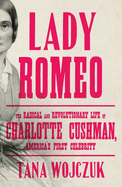
Tana Wojczuk's brisk, vibrant biography of Charlotte Cushman, the 19th-century American stage actress, by necessity contains a void: nobody currently living could have ever beheld the bold, genderbent performances that captivated audiences and made Cushman, in Wojczuk's words, the first American celebrity. But Wojczuk, a critic and editor, deftly conjures Cushman's milieu, her impact and, in vividly rendered moments rich with scenic detail, that most elusive of qualities: her presence. Cushman's life astonishes.
Queer, radical and unabashed, the Boston-born artist rose to prominence with powerful, psychologically coherent interpretations of Lady Macbeth, the prostitute Nancy from Oliver Twist and then, provocatively, as two of Shakespeare's male leads, Hamlet and Romeo. The latter made Cushman's name, in a London production co-starring her sister as Juliet. Wojczuk must rely on secondary sources to capture the essence of the performances themselves--this Romeo wooed more sensually than others--but Lady Romeo still pulses with life, especially in its accounts of Cushman's challenges to theater orthodoxy (she insisted on restoring Shakespeare's original, double-death ending, rather than the then-popular revision where the lovers live happily ever after) and social propriety (she often dressed like a man off the stage, too.)
Wojczuk's telling fizzes like champagne uncorked, attentive to fashion, gossip, scandal and Cushman's romances with a succession of women of note. Walt Whitman, Abraham Lincoln and Queen Victoria attest to Cushman's power, but it's the sculptor Emma Stebbins, eventually Cushman's life partner, who immortalized the actress: Cushman's face remains prominent in Manhattan today, the model for Stebbins's Angel of the Waters, also known as Bethesda Fountain in Central Park. --Alan Scherstuhl, freelance writer and editor

